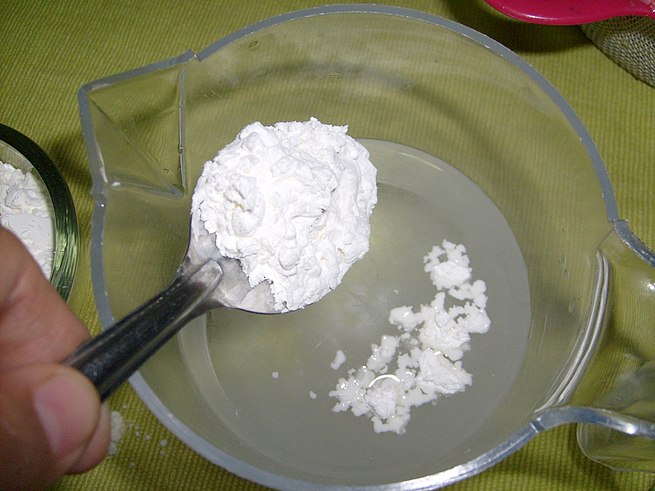Main Difference
The main difference between Starch and Polysaccharide is that the Starch is a carbohydrate consisting of a large number of glucose units joined by glycosidic bonds and Polysaccharide is a polymeric carbohydrate molecules composed of long chains of monosaccharide units bound together by glycosidic linkages and on hydrolysis give the constituent monosaccharides or oligosaccharides.
-
Starch
Starch or amylum is a polymeric carbohydrate consisting of a large number of glucose units joined by glycosidic bonds. This polysaccharide is produced by most green plants as energy storage. It is the most common carbohydrate in human diets and is contained in large amounts in staple foods like potatoes, wheat, maize (corn), rice, and cassava.
Pure starch is a white, tasteless and odorless powder that is insoluble in cold water or alcohol. It consists of two types of molecules: the linear and helical amylose and the branched amylopectin. Depending on the plant, starch generally contains 20 to 25% amylose and 75 to 80% amylopectin by weight. Glycogen, the glucose store of animals, is a more highly branched version of amylopectin.
In industry, starch is converted into sugars, for example by malting, and fermented to produce ethanol in the manufacture of beer, whisky and biofuel. It is processed to produce many of the sugars used in processed foods. Mixing most starches in warm water produces a paste, such as wheatpaste, which can be used as a thickening, stiffening or gluing agent. The biggest industrial non-food use of starch is as an adhesive in the papermaking process. Starch can be applied to parts of some garments before ironing, to stiffen them.
-
Polysaccharide
Polysaccharides () are polymeric carbohydrate molecules composed of long chains of monosaccharide units bound together by glycosidic linkages, and on hydrolysis give the constituent monosaccharides or oligosaccharides. They range in structure from linear to highly branched. Examples include storage polysaccharides such as starch and glycogen, and structural polysaccharides such as cellulose and chitin.
Polysaccharides are often quite heterogeneous, containing slight modifications of the repeating unit. Depending on the structure, these macromolecules can have distinct properties from their monosaccharide building blocks. They may be amorphous or even insoluble in water. When all the monosaccharides in a polysaccharide are the same type, the polysaccharide is called a homopolysaccharide or homoglycan, but when more than one type of monosaccharide is present they are called heteropolysaccharides or heteroglycans.Natural saccharides are generally of simple carbohydrates called monosaccharides with general formula (CH2O)n where n is three or more. Examples of monosaccharides are glucose, fructose, and glyceraldehyde. Polysaccharides, meanwhile, have a general formula of Cx(H2O)y where x is usually a large number between 200 and 2500. When the repeating units in the polymer backbone are six-carbon monosaccharides, as is often the case, the general formula simplifies to (C6H10O5)n, where typically 40≤n≤3000.
As a rule of thumb, polysaccharides contain more than ten monosaccharide units, whereas oligosaccharides contain three to ten monosaccharide units; but the precise cutoff varies somewhat according to convention. Polysaccharides are an important class of biological polymers. Their function in living organisms is usually either structure- or storage-related. Starch (a polymer of glucose) is used as a storage polysaccharide in plants, being found in the form of both amylose and the branched amylopectin. In animals, the structurally similar glucose polymer is the more densely branched glycogen, sometimes called “animal starch”. Glycogen’s properties allow it to be metabolized more quickly, which suits the active lives of moving animals.
Cellulose and chitin are examples of structural polysaccharides. Cellulose is used in the cell walls of plants and other organisms, and is said to be the most abundant organic molecule on Earth. It has many uses such as a significant role in the paper and textile industries, and is used as a feedstock for the production of rayon (via the viscose process), cellulose acetate, celluloid, and nitrocellulose. Chitin has a similar structure, but has nitrogen-containing side branches, increasing its strength. It is found in arthropod exoskeletons and in the cell walls of some fungi. It also has multiple uses, including surgical threads. Polysaccharides also include callose or laminarin, chrysolaminarin, xylan, arabinoxylan, mannan, fucoidan and galactomannan.
-
Starch (noun)
A widely diffused vegetable substance found especially in seeds, bulbs, and tubers, and extracted (as from potatoes, corn, rice, etc.) as a white, glistening, granular or powdery substance, without taste or smell, and giving a very peculiar creaking sound when rubbed between the fingers. It is used as a food, in the production of commercial grape sugar, for stiffening linen in laundries, in making paste, etc.
-
Starch (noun)
Carbohydrates, as with grain and potato based foods.
-
Starch (noun)
A stiff, formal manner; formality.
-
Starch (noun)
Any of various starch-like substances used as a laundry stiffener
-
Starch (verb)
To apply or treat with laundry starch, to create a hard, smooth surface.
“She starched her blouses.”
-
Starch (adjective)
Stiff; precise; rigid.
-
Polysaccharide (noun)
A polymer made of many saccharide units linked by glycosidic bonds.
“Cellulose, starches, and complex carbohydrates, such as glycogen, are common polysaccharides in biology.”
-
Starch (noun)
an odourless, tasteless white substance occurring widely in plant tissue and obtained chiefly from cereals and potatoes. It is a polysaccharide which functions as a carbohydrate store and is an important constituent of the human diet.
-
Starch (noun)
food containing starch
“they eat far too much starch”
-
Starch (noun)
powder or spray made from starch and used before ironing to stiffen fabric or clothing
“crisp linen, stiff with starch”
-
Starch (noun)
stiffness of manner or character
“the starch in her voice”
-
Starch (verb)
stiffen (fabric or clothing) with starch
“starch your collar to keep it straight and stiff”
-
Starch (verb)
(of a boxer) defeat (an opponent) by a knockout
“Ray Domenge starched Jeff Geddami in the first”
-
Polysaccharide (noun)
a carbohydrate (e.g. starch, cellulose, or glycogen) whose molecules consist of a number of sugar molecules bonded together.

